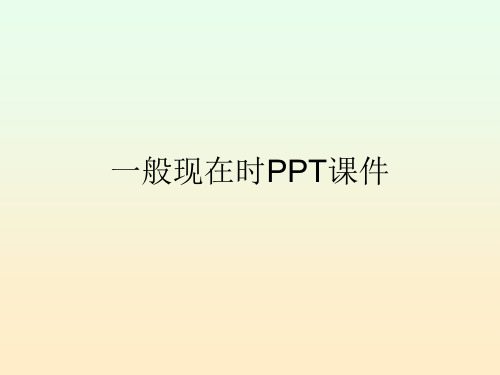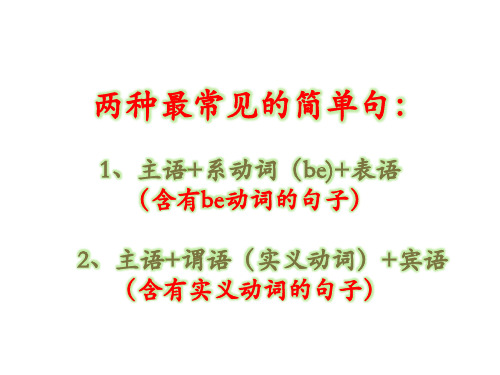一般现在时语法讲解PPT
合集下载
《一般现在时讲解》课件

一般现在时可以用来描述当前的情况或状态,例如“我现在很开心”、“她现在 是一名学生”等。这种时态强调的是当前的情况或状态,而不是过去或未来的变 化。
表示客观事实或普遍真理
总结词
描述不受时间影响的客观事实或普遍真理。
详细描述
一般现在时可以用来描述不受时间影响的客观事实或普遍真理,例如“地球是圆的”、“水在100摄氏度下沸腾 ”等。这种时态强调的是事实的普遍性和客观性,不会因为时间而改变。
I eat an apple every day. (我每天吃 一个苹果。)
结构
一般现在时的基本结构是“主语+谓 语+(宾语)+(其他成分)”,其中 谓语动词以原形或第三人称单数形式 出现。
一般现在时的特点
01
02
03
强调现在
一般现在时强调当前时间 点,表示动作或状态正在 发生或存在。
普遍性
一般现在时用于描述普遍 存在的真理、事实或习惯 性行为,不受时间限制。
总结词
动词形式不同
详细描述
一般现在时的动词形式为原型,而一般将 来时的动词形式需要用will+动词原型。
与现在进行时的对比
总结词
动作状态不同
详细描述
一般现在时表示现在的动作或状态,强调动作的持续性 ;而现在进行时表示正在进行的动作或状态,强调动作 的进行过程。
总结词
用法侧重不同
详细描述
一般现在时更侧重于描述习惯性、经常性的动作或状态 ,而现在进行时则侧重于描述当前正在发生的动作或状 态。
一般现在时的用法
表示习惯性或经常发生的动作
总结词
描述日常生活中的常见行为或习惯。
详细描述
一般现在时用于描述日常生活中的常见行为或习惯,例如“我每天早上起床” 、“他每周去健身房锻炼”等。这种时态强调行为的频繁性或习惯性,而不是 特定的一次性事件。
表示客观事实或普遍真理
总结词
描述不受时间影响的客观事实或普遍真理。
详细描述
一般现在时可以用来描述不受时间影响的客观事实或普遍真理,例如“地球是圆的”、“水在100摄氏度下沸腾 ”等。这种时态强调的是事实的普遍性和客观性,不会因为时间而改变。
I eat an apple every day. (我每天吃 一个苹果。)
结构
一般现在时的基本结构是“主语+谓 语+(宾语)+(其他成分)”,其中 谓语动词以原形或第三人称单数形式 出现。
一般现在时的特点
01
02
03
强调现在
一般现在时强调当前时间 点,表示动作或状态正在 发生或存在。
普遍性
一般现在时用于描述普遍 存在的真理、事实或习惯 性行为,不受时间限制。
总结词
动词形式不同
详细描述
一般现在时的动词形式为原型,而一般将 来时的动词形式需要用will+动词原型。
与现在进行时的对比
总结词
动作状态不同
详细描述
一般现在时表示现在的动作或状态,强调动作的持续性 ;而现在进行时表示正在进行的动作或状态,强调动作 的进行过程。
总结词
用法侧重不同
详细描述
一般现在时更侧重于描述习惯性、经常性的动作或状态 ,而现在进行时则侧重于描述当前正在发生的动作或状 态。
一般现在时的用法
表示习惯性或经常发生的动作
总结词
描述日常生活中的常见行为或习惯。
详细描述
一般现在时用于描述日常生活中的常见行为或习惯,例如“我每天早上起床” 、“他每周去健身房锻炼”等。这种时态强调行为的频繁性或习惯性,而不是 特定的一次性事件。
一般现在时ppt课件完整版

不可数名词作主语时,谓语动词用单数 形式。
可数名词单数作主语时,谓语动词也用 单数形式。
例如:Water is essential for life.(水 对生命至关重要。)/ A book is on the table.(一本书在桌子上。)
例外情况总结
当主语为并列主语时,谓语动词的数要与靠近它的主语保持一致。
练习3答案
reads。解析:主语 She 是第三人称单数 ,且时间状语为 on weekends,表示经 常性动作,所以谓语动词要用单数形式 reads。
THANKS
时间状语分类及举例
表示经常性或习惯性的动作
always, usually, often, sometimes
表示现在的状态或特征
now, at present, these days
表示普遍真理或客观事实
in general, as a rule
频率副词分类及举例
01
高频副词
always, constantly, continually
注意区分完全否定和部分否定。完全 否定表示全部否定,而部分否定表示 部分否定。例如,“None of the students passed the exam.”(没 有一个学生通过了考试)是完全否定 ;“Not all of the students passed the exam.”(并非所有学生都通过 了考试)是部分否定。
does he work?等。
动词短语和情态动词的变化规则
03
动词短语中的动词和情态动词后接动词原形,如I can swim,
they often go out等。
02 肯定句结构与用法
主语+动词原形+其他成分
一般现在时.语法讲解

A. have, have B. has, has
C. have, has have
D. has,
2. If their house ___ not like ours, what___ it look like?
精品课件
3. - ___ you think he will come?
ቤተ መጻሕፍቲ ባይዱ
- If it ___ tomorrow, he will not come.
I run very fast.
否定句:I don’t run very 一fa般st疑.问句:Do you run very fast ?
肯定回答:Yes, I do.
否定回答: No, I don’t.
2.e.g.
She likes Maths.
否定句:She doesn’t like Maths. 一般疑问句:Does she like Maths?
精品课件
(2).情态动词 e.g.
She can speak Chinese. 否定句:She can’t speak Chinese. 一般疑问句:Can she speak Chinese?
肯定回答:Yes, she can. 否定回答:No, she can’t.
精品课件
(3)行为动词
1.e.g.
3.My brother works in a factory.
My brother doesn’t work in a radio factory. Does your brother work精s品课i件n a radio
三、单项选择
1. The Browns ___ a nice car and Brown's brother __ a nice jeep.
(完整版)一般现在时PPT课件.ppt

7. Tom can not walk fast because he _c_a_r_r_ie_s(carry) a heavy box.
用动词的适当形式填空
1.She ____(go) to school at eight o’clock.
2. He usually _____ up at 17:00.(get )
直接加s
Fly-flies;ห้องสมุดไป่ตู้stay-stays
• 第三节 • 特殊疑问句
• I clean the window at home on Saturdays.
• 1、对主语提问:
• Who cleans the window at home on Saturdays?
• 2、对宾语提问:
Has David got a goal?
7. We have four lessons.(否定句) We don’t have four lessons.
8. Nancy doesn’t run fast (肯定句)
Nancy runs fast. 9. My dog runs fast. 否定句:My dog doesn’t run fast.
5. Danny_s_t_u_d_ie_s__(study) English, Chinese, Maths, Science and Art at school.
6. Mike sometimes g_o__e_s_(go) to the park with his sister.
7. At eight at night, she w__a_tc_hes (watch) TV with his parents. 8. _D_o_e_s_ Mike r_e_a_d_(read) English every day?
初中英语语法之 一般现在时 PPT课件 图文

2.用括号内动词的适当形式填空。 1. We often_______(play) in the playground. 2. He _______(get) up at six o’clock. 3.____you______(brush) your teeth every morning. 4. What______ (do) he usually____ (do) after school? 5.Danny_______(study)English, Chinese, Maths, Science and Art at school.
How old _a_r_eyou? Where a_r_e_ they ?
小结:be 动词的一般现在时的句式: 肯定句:主语+be+表语(n., adj.等)
否定句:主语+be+ not+表语.
一般疑问句:Be+主语+表语?
特殊疑问句:疑问词+be+主语?
2.实义动词的一般现在时句式: 肯定句: 主语(非三单)+v.原形+其他. 1) I _s_ta_y___ (stay) at home on Saturdays. 2) They h__a_v_e_ (have) sports every day. 3) My parents _g_iv_e_(give) me ten yuan
What _d_o_e_s_ she_w_a_n_t_ (want)? What time _d_o_you_h_a_v_e_ (have) lunch? What time d_o_e_s_she_h_a_v_e(have) lunch?
What _d_o__ you _d_o_(do)? What _d_o_e_s__ she _d_o__(do)? How __d_o_ you_sp__el_l (spell) it? How _d_o_e_s_ he s_p_e_l_l _(spell) it?
初中英语语法基本时态-(一般现在时和一般过去时)课件

1、含有be动词的句子,一般现在时be(am,is, are)要变否定句和一般疑问句就根据be动词用法口 诀走:
be动词有3个am/is/are,具体用哪一个根据主 语的变化而变化,我是am,I am,你是are, You are, 还有We are 和They are, is 连着他她 它,he is; she is; it is, 单数名词用is ,复数名 词全用are,变疑问(be)往前提,句末问 号莫忘记,变否定更容易be后not莫忘记, 疑问否定任你变句首大写莫迟疑。
我喜欢打豆豆。我天天打豆豆。 我正在打豆豆。 我以前不打豆豆。 我昨天早上正在打豆豆。 我今天早上已经打过豆豆了。 昨天下午之前我已经打过豆豆了。
过去
↑
1995
2008
↓
现在
将来
↑
2030
2018
↓
年份
一般现在时的概念: 1、表示习惯性或经常性的动作或状态
I often take school bus to school.
❖答案:1. Does have 2. doesn't live 错误:1. Does has 2. not live
❖解析: ❖ 单三人称做主语的一般现在时做句式变化时,可记 住如下口诀:“见助动,用原形”。此口诀也可推广用于 一般过去时态中。 ❖ 例如: He didn't go home yesterday.
❖ 时间状语:
often(经常)、 usually(通常)、 always (总是)、 sometimes(有时)等频率副词, on Saturdays(在星期六)、 in the morning(afternoon evening)(在早上(下午 晚上)) 、every day(每天) 等。
be动词有3个am/is/are,具体用哪一个根据主 语的变化而变化,我是am,I am,你是are, You are, 还有We are 和They are, is 连着他她 它,he is; she is; it is, 单数名词用is ,复数名 词全用are,变疑问(be)往前提,句末问 号莫忘记,变否定更容易be后not莫忘记, 疑问否定任你变句首大写莫迟疑。
我喜欢打豆豆。我天天打豆豆。 我正在打豆豆。 我以前不打豆豆。 我昨天早上正在打豆豆。 我今天早上已经打过豆豆了。 昨天下午之前我已经打过豆豆了。
过去
↑
1995
2008
↓
现在
将来
↑
2030
2018
↓
年份
一般现在时的概念: 1、表示习惯性或经常性的动作或状态
I often take school bus to school.
❖答案:1. Does have 2. doesn't live 错误:1. Does has 2. not live
❖解析: ❖ 单三人称做主语的一般现在时做句式变化时,可记 住如下口诀:“见助动,用原形”。此口诀也可推广用于 一般过去时态中。 ❖ 例如: He didn't go home yesterday.
❖ 时间状语:
often(经常)、 usually(通常)、 always (总是)、 sometimes(有时)等频率副词, on Saturdays(在星期六)、 in the morning(afternoon evening)(在早上(下午 晚上)) 、every day(每天) 等。
2024年中考英语语法复习——一般现在时课件

studies
★以y结尾的单词,但y之前有元音字母时, 直接加s,如:say→says,pay→pays等。
★be 动词的第三人称单数是is。
★have的第三人称单数为has。
2)He/She/It does...的不同句式
① 一般疑问句:Does he/she/it (do)...?
陈述句:He goes to school every day.他每天去学校。 一般疑问句:Does he go to school every day?他每天去学校吗?
b.针对地点提问
Where does he draw? 他在哪里画画?
Where does your brother play games? 你弟弟在哪里玩游戏?
c.针对方式提问 How does she go to school? 她是怎么去学校的? How does he get to the airport? 他是怎么到达机场的? d.针对时间提问 When does Danny get up? 丹尼是几点起床的? What time does your father go to work? 你父亲几点上班?
(这里的run,go,see 就是实义动词,在句 中用原形。)
2.一般疑问句:Do you...?
陈述句:I see the rainbow.我看见彩虹 一般疑问句:Do you see the rainbow?你看到彩虹了吗?
陈述句:Ilike myjourney.我喜欢这次旅行。 一般疑问句:Doyou like your journey?你喜欢你这次旅行吗?
be动词在一般现在时态中的各种句型:
1.肯定句:主语+be+其他
You are a good girl. 你是一个好女孩。
★以y结尾的单词,但y之前有元音字母时, 直接加s,如:say→says,pay→pays等。
★be 动词的第三人称单数是is。
★have的第三人称单数为has。
2)He/She/It does...的不同句式
① 一般疑问句:Does he/she/it (do)...?
陈述句:He goes to school every day.他每天去学校。 一般疑问句:Does he go to school every day?他每天去学校吗?
b.针对地点提问
Where does he draw? 他在哪里画画?
Where does your brother play games? 你弟弟在哪里玩游戏?
c.针对方式提问 How does she go to school? 她是怎么去学校的? How does he get to the airport? 他是怎么到达机场的? d.针对时间提问 When does Danny get up? 丹尼是几点起床的? What time does your father go to work? 你父亲几点上班?
(这里的run,go,see 就是实义动词,在句 中用原形。)
2.一般疑问句:Do you...?
陈述句:I see the rainbow.我看见彩虹 一般疑问句:Do you see the rainbow?你看到彩虹了吗?
陈述句:Ilike myjourney.我喜欢这次旅行。 一般疑问句:Doyou like your journey?你喜欢你这次旅行吗?
be动词在一般现在时态中的各种句型:
1.肯定句:主语+be+其他
You are a good girl. 你是一个好女孩。
一般现在时语法总结 PPT

常用的状语:often , sometimes , usually , every day 等。
3.表主语具备的性格和能力等:
e.g. She likes noodles.
They speak French.
4.表示不受时间限制的普遍真理和自然规律:
e.g. Two and four is six.
这类sta用rt法出限发于,表be示gin“开移始动,”的a动rri词ve:到g达o去,,tackoemofef来起,飞l,ea等ve。离开,
5
常用的时间状语
1.频度副词: sometimes(有时), often, always(总是), usually(通常), seldom, never(决不) twice a week,seldom,once a month, on Sundays
一般现在时
1
定义
一般现在时:表示通常性、规律性、习惯性的 状态或者动作(有时间规律发生的事件)的一
种时间状态
2
Hale Waihona Puke 1.表示现在的状态: e.g. He’s twelve.
具体用法
She’s at work.
2.表经常或习惯性的动作:
e.g. I get up at 6:30 every day.
He reads English every morning.
我们通常7:30上学去。[go]
2) My parents give ten yuan to my sister every week. 我父母每星期给我妹妹十元钱。
❖ 2.主语是任何一个单数名词或者是第三人称 单数,谓语动词要进行必要的变化。特别 提一点:不可数名词也算作单数处理。
一般现在时ppt讲解

三、单数可数名词或"this / that / the+单数可数名词"作主语时,是第三人称单数。
A panda is a shy animal. 熊猫是害羞的动物。 is book is yellow. 这本书是黄色的。 at car is red. 那辆小汽车是红色的。 e cat is black. 这只猫是黑色的。
一、he, she, it是第三人称单数。
Han Mei looks like her mother. 韩梅看起来像她的母亲 Beijing is in China. 北京在中国。 Uncle Wang often makes cakes. 王叔叔经常做蛋糕。
二、单个人名、地名或称呼作主语;是第三人称单数。
否定句在be动词和情态动词后加not
A
B
C
D
E
F
一般现在时 (否定句)
无be动词或情态动词时
主语第三人称单数 动词前加does not (doesn’t) 主语是非单三 动词前加 do not(don’t)
一般现在时 (否定句) go don’t go goes doesn’t go
单击此处添加正文,文字是您思想的提炼,为了演示发布的良好效果,请言简意赅地阐述您的观点。
用一般现在时态描述下your good friend ——Mike
有be动词或情态动词时 be动词或情态动词can提前,首字母变为大写;some 变any
一般现在时 (疑问句)
一般现在时 (一般疑问句)
He is a stu he a student? Are you a boy? I can swim. I am a teacher. Can you swim? Are you a teacher?
A panda is a shy animal. 熊猫是害羞的动物。 is book is yellow. 这本书是黄色的。 at car is red. 那辆小汽车是红色的。 e cat is black. 这只猫是黑色的。
一、he, she, it是第三人称单数。
Han Mei looks like her mother. 韩梅看起来像她的母亲 Beijing is in China. 北京在中国。 Uncle Wang often makes cakes. 王叔叔经常做蛋糕。
二、单个人名、地名或称呼作主语;是第三人称单数。
否定句在be动词和情态动词后加not
A
B
C
D
E
F
一般现在时 (否定句)
无be动词或情态动词时
主语第三人称单数 动词前加does not (doesn’t) 主语是非单三 动词前加 do not(don’t)
一般现在时 (否定句) go don’t go goes doesn’t go
单击此处添加正文,文字是您思想的提炼,为了演示发布的良好效果,请言简意赅地阐述您的观点。
用一般现在时态描述下your good friend ——Mike
有be动词或情态动词时 be动词或情态动词can提前,首字母变为大写;some 变any
一般现在时 (疑问句)
一般现在时 (一般疑问句)
He is a stu he a student? Are you a boy? I can swim. I am a teacher. Can you swim? Are you a teacher?
小学英语时态语法:现在进行时、一般现在时时态讲解PPT课件

is jumping
monkey ______ ______ up and down.
Homework: Finish the exercise6.
谢谢大家!
home. 4. What time __do_e_s__ the shop _c_lo_se___ (close)? It _c_lo_se_s_ (close)
at nine o'clock in the evening.
5.Miss Guo __tea_c_he_s_ (teach) us Chinese this term. She ___is___ (be) a very good teacher. She often __ta_lk_s __ (talk) with us after class. Many of us like __ta_lk_in_g _ (talk) with her. Now, she _i_s _ta_lki_ng_ (talk) with Lily.
小学英语时态语法:现在进行时、 一般现在时时态讲解PPT课件
一、现在进行时的定义:表示现在正在进行或发生的动
作 。(句中一般含有now, 单独的look或 listen出现
在句首.)
二、它的结构:be + 动词ing 形式
三、动词加ing的变化规则 1.一般情况下,直接加ing,如:cook-cooking 2.以不发音的e结尾,去e加ing,如:make-making,
改句子 1. Do you often play football after school? (肯定回答)
Yes, we do.
2. I have some books. (改为否定句) I _d_o_n_’t _h_a_v_e_ _a_n_y___ books.
monkey ______ ______ up and down.
Homework: Finish the exercise6.
谢谢大家!
home. 4. What time __do_e_s__ the shop _c_lo_se___ (close)? It _c_lo_se_s_ (close)
at nine o'clock in the evening.
5.Miss Guo __tea_c_he_s_ (teach) us Chinese this term. She ___is___ (be) a very good teacher. She often __ta_lk_s __ (talk) with us after class. Many of us like __ta_lk_in_g _ (talk) with her. Now, she _i_s _ta_lki_ng_ (talk) with Lily.
小学英语时态语法:现在进行时、 一般现在时时态讲解PPT课件
一、现在进行时的定义:表示现在正在进行或发生的动
作 。(句中一般含有now, 单独的look或 listen出现
在句首.)
二、它的结构:be + 动词ing 形式
三、动词加ing的变化规则 1.一般情况下,直接加ing,如:cook-cooking 2.以不发音的e结尾,去e加ing,如:make-making,
改句子 1. Do you often play football after school? (肯定回答)
Yes, we do.
2. I have some books. (改为否定句) I _d_o_n_’t _h_a_v_e_ _a_n_y___ books.
一般现在时PPT课件

Does Kate like singing every morning?
Lily often writes to her uncle in Canada. Does Lily often write to her uncle in
Canada?
2021
20
D. 特殊疑问句: 疑问词+一般疑问句?
2021
9
频率副词在句中的位置:
1. 频率副词用在be动词后。 It is usually hot in summer.
2. 频率副词用在实义动词前。 My father usually walks home.
3. 频率副词用在助动词与实义动词之间。 I will always love you.
like—likes get--gets
go—goes watch--watches study—studies fly--flies play—plays stay--stays have—has be--is
2021
13
Practice one
写出下列单词的第三人称单数形式 live------ __liv_e_s_____ discuss---d_i_sc_u_s_s_e_s have--- ____h_a_s__ hurry--- h_u_r_ri_e_s___ go---- _____g_o_e_s wash--- __w__a_s_h_e_s stay-------- _s_t_a_y_s____ be---___is_____ enjoy------ __e_n_jo_y_s___ collect---- _c_o_ll_e_ct_s_
2021
17
• A. 肯定句: • 主语(I/We/You/They)+动词原形+其他 • 主语(He/She/It)+动词的s形式+其他 We often play basketball in the playground. Mary studies English, Chinese at school.
初中英语语法时态(共25张PPT)

A.goes B.will go
C.would go D.are going
2.--Did your son fail his English exam once again?
--Yes, but he told me he____hard next term.
A.studies B.is studying C.will studyD.would study
2 have been to+地点,表示“去过某
地”。(人已回) I have been to Europe. (I am not in Europe now.)
3 have been in+地点+时间段,表示“在/ 来某地多久”。
I have been in Europe for three weeks. (I am now still in Europe .)
3.现在完成时和一般过去时的异同点: 1 共同点:动作都在过去。 2 不同点:和现在有无关系。(与现
在有关的过去动作用现在完成,与现在 无关的过去动作用一般过去。)
4.易错点:
1 have gone to+地点,表示“去了某地”。
(人已走,尚未回。只用于第三人称。)
They have gone to Europe. (They are not here.)
C.didn’t he
D.did he
三、现在进行时
1.用法:
A.现刻动作:目前正在发生的动作。
B.现阶段动作:目前一个时期一直在进 行的动作,此刻不一定在进行。
2.标志词:now,Look! Listen!
中考模拟:
--Mike, who____football in the yard?
人教版初中英语七年级上册第四单元《一般现在时》语法教学PPT课件

肯定变否定,be后加not
01 概念与用法
一般疑问句结构变化
Are you a good person? Is she/he a good person.
肯定句变一般疑问句,只需将 be动词提前
行为动词 的一般现在时是怎么构成的呢?
01 概念与用法
观察下列句子
1、I play football every day . 2、You play football every day . 3、My friends play football every day . 4、He plays football every day . 5、Tom plays football every day . 6、My brother plays football every day .
01 概念与用法
第三人称单数变化规则
一般动词后加-s。 like--likes He likes playing basketball.
以辅音字母+y结尾的单词, 变y为i,再加-es。 study--studies He studies English very hard.
以s、x、ch、sh结尾,后加es。 watch--watches My father watches TV every night.
Part. five
课后作业
改错题 1.Our English doesn’t likes music. 2. Tony goes always to school at eight o’clock. 3. Does your parents like watching TV? 4. Lily haves lunch at school. 5. My sister doesn’t her homework every .
01 概念与用法
一般疑问句结构变化
Are you a good person? Is she/he a good person.
肯定句变一般疑问句,只需将 be动词提前
行为动词 的一般现在时是怎么构成的呢?
01 概念与用法
观察下列句子
1、I play football every day . 2、You play football every day . 3、My friends play football every day . 4、He plays football every day . 5、Tom plays football every day . 6、My brother plays football every day .
01 概念与用法
第三人称单数变化规则
一般动词后加-s。 like--likes He likes playing basketball.
以辅音字母+y结尾的单词, 变y为i,再加-es。 study--studies He studies English very hard.
以s、x、ch、sh结尾,后加es。 watch--watches My father watches TV every night.
Part. five
课后作业
改错题 1.Our English doesn’t likes music. 2. Tony goes always to school at eight o’clock. 3. Does your parents like watching TV? 4. Lily haves lunch at school. 5. My sister doesn’t her homework every .
初中英语语法 一般现在时、过去时、将来时完整ppt课件

egtwoplusfourmoongoesaround经常性习惯性的动作经常性习惯性的动作目前的爱好能力目前的爱好能力客观事实客观事实动词三单形式规则变法
一般现在时、一般过去时 、将来时
精选课件PPT
1
Let's distinguish!
1. He does his homework every day. 2. I am a teacher. 3. We played the piano last Sunday. 4. They were at school just now.
going to 多用于自己打算、计划或有意做某事。
• 二、探究:
•1、动词come/go/leave/move/arrive/start等不和be going to连用,常用be
coming/going/leaving/moving/arriving/starting等来表示即将发生或安排好要做
的事。
---I ______ to the Great Wall.
A. go B. went
C. will go D. have gone
精选课件PPT
11
一一.一般般将将来来时时是(S表im示p从le现在fu开tu始re将t来en要s发e)生的事。
二.肯定句构成: 1. be going to do sth. 2. will / shall do sth.
Yes, they were.
No, they weren’t.
He could swim at the age of ten.
He couldn’t swim at the age of ten.
It took two hours to go there.
一般现在时、一般过去时 、将来时
精选课件PPT
1
Let's distinguish!
1. He does his homework every day. 2. I am a teacher. 3. We played the piano last Sunday. 4. They were at school just now.
going to 多用于自己打算、计划或有意做某事。
• 二、探究:
•1、动词come/go/leave/move/arrive/start等不和be going to连用,常用be
coming/going/leaving/moving/arriving/starting等来表示即将发生或安排好要做
的事。
---I ______ to the Great Wall.
A. go B. went
C. will go D. have gone
精选课件PPT
11
一一.一般般将将来来时时是(S表im示p从le现在fu开tu始re将t来en要s发e)生的事。
二.肯定句构成: 1. be going to do sth. 2. will / shall do sth.
Yes, they were.
No, they weren’t.
He could swim at the age of ten.
He couldn’t swim at the age of ten.
It took two hours to go there.
一般现在时(示范课)ppt课件精选全文

精选课件
27
• 3. Daniel enjoys playing computer games.
• (改为一般疑问句并做肯定回答)
Does Daniel enjoy playing computer games?
Yes, he does.
精选课件
28
补充:some、any
• 一般说来,some 用于肯定句中,any 用于 否定句和疑问句中 。
Change the following sentences after the models.
Model 1: I like fish. (meat) I don’t like meat.
Model 2. He likes reading. (writing) He doesn’t like writing.
改疑问句或否定句时,原句里的some要改成any
There are some books on the desk. (改为否定句)
→There aren’t any books on the desk.
→Are there any books on the desk?
精选课件
29
Why not buy some apples? 为什么不买些苹果呢?
精选课件
26
句型转换
• 1. Mr. Green comes from Shanghai. • (改为一般疑问句)
Does Mr. Green come from Shanghai?
• 2. Millie lives in a flat in Beijing. • (改为否定句)
Millie doesn’t live in a flat in Beijing.
- 1、下载文档前请自行甄别文档内容的完整性,平台不提供额外的编辑、内容补充、找答案等附加服务。
- 2、"仅部分预览"的文档,不可在线预览部分如存在完整性等问题,可反馈申请退款(可完整预览的文档不适用该条件!)。
- 3、如文档侵犯您的权益,请联系客服反馈,我们会尽快为您处理(人工客服工作时间:9:00-18:30)。
3. - ___ you think he will come?
- If it ___ tomorrow, he will not come.
A. Do, rains
B. Are, rains
C. Do, will rain D. Are, will rain
4. The little child__ not even know
1、表示目前或现在存在的状态或特征. e.g. She is often late.
2、表示客观存在及普遍真理。 e.g. The earth is round. 3、表示现在经常和习惯性发生的动作,常与
sometimes, often, usually, always, everyday… 等时间状语连用。
4、在时间状语从句中表示将来发生的动作。 e.g. If it doesn’t rain tomorrow, we’ll go to the park.
5、表示按时间或计划将要发生的动作,常与时 间状语连用,常用动词为:
come, begin, go, leave, arrive, stop, start, return, E.g. Our holidays begin in a week.
that the moon __ around the earth.
A. do, move B. do, moves
C. does, moves D. did, moved
结语
谢谢大家!
3.My brother works in a factory.
My brother doesn’t work in a radio factory. Does your brother works in a radio factory?
三、单项选择
1. The Browns ___ a nice car and Brown's brother __ a nice jeep.
(3)行为动词
1.e.g. I run very fast.
否定句:I don’t run very fast . 一般疑问句:Do you run very fast ? 肯定回答:Yes, I do.
否定回答: No, I don’t. 2.e.g. She likes Maths.
否定句:She doesn’t like Maths. 一般疑问句:Does she like Maths? 肯定回答:Yes, she does.
否定回答: No, she doesn’t.
注意:在一般现在时态中,当谓语动词是 行为动词的时候,变否定和一般疑问句时, 要借助助动词do和does帮忙。当主语是第 三人称单数(she, he, it)的时候用does, 其他人称用do. 借助助动词do和does以后, 动词要用动词原形。
Ⅲ 、一般现在时态的用法:
注意:在一般现在时态的肯定句中-s或者 –es.
2.一般现在时态的否定和疑问式 (1).Be动词
肯定句:She is a student. 否定句:She is not a student .
一般疑问句:Is she a student ? 肯定回答:Yes ,she is .
A. have, have B. has, has
C. have, has D. has, have
2. If their house ___ not like ours, what___ it look like?
A. is, is
B. is, does
C. does, does D. does, is
否定回答: No ,she isn’t.
(2).情态动词 e.g.
She can speak Chinese. 否定句:She can’t speak Chinese. 一般疑问句:Can she speak Chinese? 肯定回答:Yes, she can. 否定回答:No, she can’t.
him. 8.How __is__(be) your father ? 9.There _is___ (be) a school there.
Ⅵ 、 Homework
一、写出下列动词第三人称单数的变化形式
➢be ➢have ➢come ➢go ➢stay ➢teach
➢write ➢take ➢study ➢watch ➢fly ➢play
Ⅳ 、 就单词的正确形式填空
1.He _l_o_ok_s_ (look) tired. 2.The earth_g_o_es (go) round the sun. 3. M__a_y (may) I have your pen? 4.Practice _m_a_k_e_s _ (make) perfect. 5.They usually_co_m_e_ (come) to school earlier. 6.Class_b_e_gi_n_s (begin) at eight every morning. 7.When hec_o_m_es (come), we’ll go out to meet
I can speak English. She must go to school.
3).主语+行为动词(speak,say,call,go, run….) 1)I speak English.
2)She/He/It speaks English.
3)They call me Tom.
4)He runs very fast.
一般现在时语法讲解PPT
Ⅰ、概念:
经常、反复发生的动作或存在的状态及 现在的某种状态。
Ⅱ 、构成形式:
1 、肯定式 1)主语 + be (am/is/are)+表语
I am a student. It/ She/He is a teacher. You/They are classmates. 2)主语 +情态动词(can, must, may, need, shall)
二、将下列句子变成否定式和一般疑问句
1.Her name is Li Ling.
Her name isn’t Li Ling. Is she Li Ling ?
2.We go to school at night.
We don’t go to school at night Do you go to school at night?
